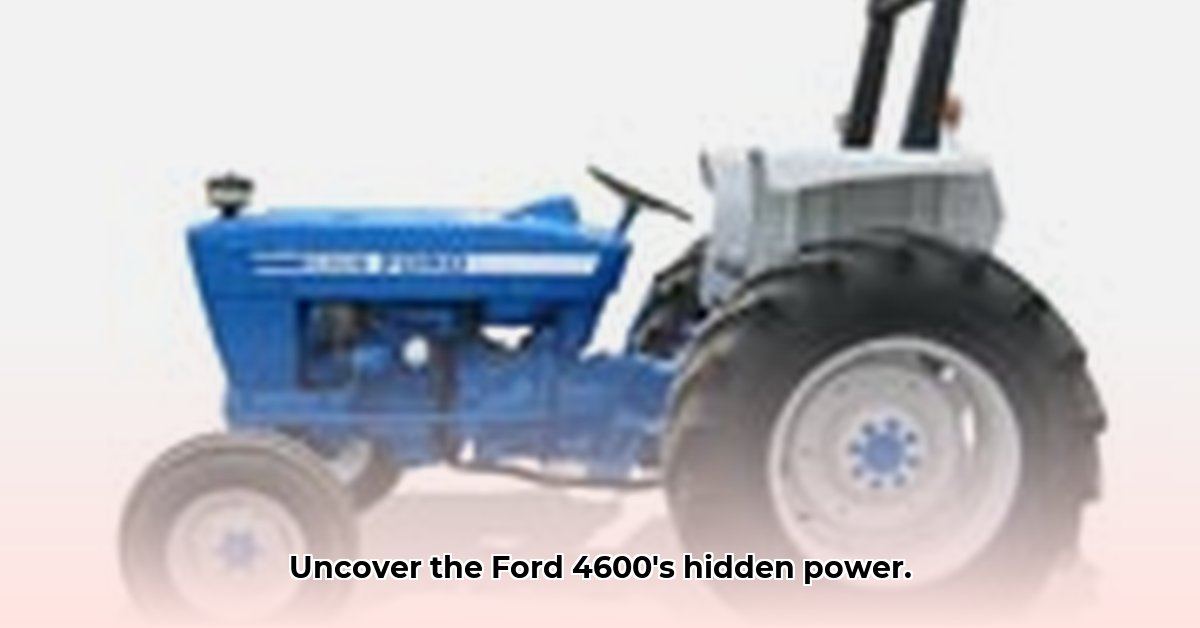
Understanding the Ford 4600's Power: A Deep Dive into its Capabilities
The Ford 4600, a stalwart of the late 1970s farming landscape, offered a compelling blend of power and versatility. But how much horsepower did this iconic machine actually deliver? The answer isn't a single number, but rather a range reflecting the available engine options. Farmers could choose between a 3.3-liter, three-cylinder diesel engine and a gasoline variant. Both produced a net horsepower output of approximately 56 to 60 hp. While seemingly modest by today's standards, this power was more than adequate for a wide range of tasks on smaller farms or those needing a compact yet capable machine. This output was competitive with other utility tractors of its era. Was this power sufficient for large-scale operations? No, it was geared towards smaller-scale farming needs. For more detailed specifications, check out this helpful resource: Ford 4600 HP.
The Ford 4600's Transmission: A Reliable System for Optimal Performance
The Ford 4600’s engine power was effectively harnessed through a straightforward eight-forward, two-reverse gear transmission. This simple yet reliable system provided farmers with ample control over the tractor's speed and power application. Unlike modern tractors with sophisticated electronic transmissions, the 4600's mechanical system prioritized robustness and ease of maintenance. This design philosophy reflected the era's focus on dependable, low-maintenance machinery. How did this mechanical simplicity contribute to the tractor's overall appeal to farmers? It fostered reliability and ease of maintenance.
The Ford 4600 in Context: A Workhorse for its Time
To fully appreciate the Ford 4600's power, we must consider its historical context. Introduced in the late 1970s, its horsepower output placed it firmly within the competitive landscape of utility tractors. Its true strength lay not solely in raw power but in its versatility. It was designed to efficiently handle a wide variety of tasks, from plowing fields to hauling loads. This adaptability made it a popular choice among farmers seeking a dependable all-around tractor. What key factors drove the Ford 4600's popularity among farmers? Its versatility and dependability.
Ford 4600 Tractor Specifications: A Detailed Overview
| Feature | Description | Notes |
|---|---|---|
| Engine Options | 3.3L 3-cylinder diesel and gasoline | Gasoline engines were less common due to diesel's greater fuel efficiency. |
| Net Horsepower | Approximately 56-60 hp | This is a net horsepower rating, accounting for power transmission losses. |
| Transmission | 8 forward gears, 2 reverse gears | Mechanical transmission; known for simplicity, reliability, and ease of maintenance. |
| Three-Point Hitch | Category I | Standard for attaching implements; lifting capacity was more limited compared to later models. |
| Brakes | Mechanical wet disc brakes | Effective braking; required regular maintenance. |
| Steering | Power steering | Enhanced ease of operation, particularly during extended periods of use. |
| Weight | Approximately 4480-5880 lbs (varied based on equipment) | Weight fluctuated depending on added implements and attachments. |
| Fuel Tank Capacity | Approximately 16 gallons (varies by source) | Fuel efficiency has been a topic of discussion among tractor owners. |
A Balanced Perspective: Strengths and Weaknesses of the Ford 4600
While the Ford 4600 served farmers faithfully, it possessed both strengths and weaknesses. Understanding these aspects provides a complete picture of its capabilities and limitations:
Advantages:
- Dependability: Renowned for its reliable performance across a range of farming tasks.
- Maneuverability: Compact size made it suitable for tight spaces and various applications.
- Simple Mechanics: Relatively easy to understand and maintain compared to modern tractors, potentially reducing repair costs.
- Parts Availability (Restoration): Many parts remain accessible through restoration communities.
Disadvantages:
- Lower Horsepower (Relative to Modern Models): Power output is significantly lower than modern tractors, limiting its suitability for large-scale operations.
- Limited Advanced Features: Lacks advanced electronic features and automation found in newer models.
- Maintenance Skill: Repair and maintenance might require more mechanical expertise than some more modern tractors.
- Parts Availability (General): Sourcing parts outside restoration circles can be challenging.
The Enduring Legacy of the Ford 4600
The Ford 4600's impact on agriculture transcends its horsepower rating. It represents a significant era in farming technology, providing a reliable and adaptable solution for countless farmers. Its enduring legacy lies in its robust design, dependable performance, and accessible nature, making it a trusted workhorse for a generation. The tractor’s lasting appeal remains strong even today. Why did the Ford 4600 garner such enduring respect from farmers? It delivered reliable performance and ease of maintenance in a simple, accessible package.
Restoring a Ford 4600 Tractor: A Comprehensive Guide
Restoring a Ford 4600 is a significant undertaking, requiring a combination of experience, patience, and attention to detail. This involves careful planning, meticulous work, and possibly considerable investment. Prioritizing essential repairs initially is crucial; begin with those systems that ensure safe operation.
Key Steps in Restoration:
- Assessment: Begin with a thorough inspection, documenting all aspects of the tractor's condition.
- Prioritization: Focus on essential repairs: engine (if needed), transmission, PTO, hydraulics, steering, and brakes.
- Parts Sourcing: Locate necessary parts through various channels, including online marketplaces and classic tractor parts suppliers.
- Phased Restoration: Break down the project into manageable phases: disassembly, cleaning, repair, reassembly, testing, and cosmetic restoration.
By following these steps, you can bring your classic Ford 4600 back to its former glory and preserve a piece of agricultural history. The horsepower of your restored Ford 4600 will be a testament to your dedication and skill.